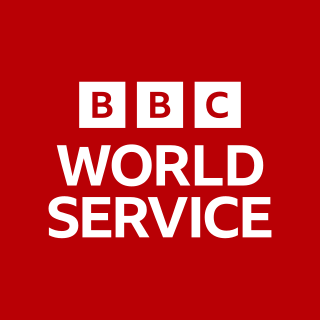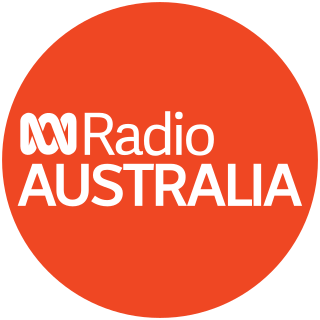
The BBC World Service is an international broadcaster owned and operated by the BBC, with funding from the British Government through the Foreign Secretary's office. It is the world's largest external broadcaster in terms of reception area, language selection and audience reach. It broadcasts radio news, speech and discussions in more than 40 languages to many parts of the world on analogue and digital shortwave platforms, internet streaming, podcasting, satellite, DAB, FM and MW relays. In 2015, the World Service reached an average of 210 million people a week. In November 2016, the BBC announced that it would start broadcasting in additional languages including Amharic and Igbo, in its biggest expansion since the 1940s.

Shortwave radio is radio transmission using shortwave (SW) radio frequencies. There is no official definition of the band, but the range always includes all of the high frequency band (HF), which extends from 3 to 30 MHz ; above the medium frequency band (MF), to the bottom of the VHF band.

Voice of America is the state-owned international radio broadcaster of the United States of America. It is the largest and oldest U.S.-funded international broadcaster. VOA produces digital, TV, and radio content in 47 languages which it distributes to affiliate stations around the globe. It is primarily viewed by a non-American audience.
International broadcasting, in a limited extent, began during World War I, when German and British stations broadcast press communiqués using Morse code. With the severing of Germany's undersea cables, the wireless telegraph station in Nauen was the country's sole means of long-distance communication.
A numbers station is a shortwave radio station characterized by broadcasts of formatted numbers, which are believed to be addressed to intelligence officers operating in foreign countries. Most identified stations use speech synthesis to vocalize numbers, although digital modes such as phase-shift keying and frequency-shift keying, as well as Morse code transmissions, are not uncommon. Most stations have set time schedules, or schedule patterns; however, other stations appear to have no discernible pattern and broadcast at random times. Stations may or may not have set frequencies in the high frequency band.

Radio broadcasting is transmission of audio (sound), sometimes with related metadata, by radio waves to radio receivers belonging to a public audience. In terrestrial radio broadcasting the radio waves are broadcast by a land-based radio station, while in satellite radio the radio waves are broadcast by a satellite in Earth orbit. To receive the content the listener must have a broadcast radio receiver (radio). Stations are often affiliated with a radio network which provides content in a common radio format, either in broadcast syndication or simulcast or both. Radio stations broadcast with several different types of modulation: AM radio stations transmit in AM, FM radio stations transmit in FM, which are older analog audio standards, while newer digital radio stations transmit in several digital audio standards: DAB, HD radio, DRM. Television broadcasting is a separate service which also uses radio frequencies to broadcast television (video) signals.

Radio Televisión Martí is an American state-run radio and television international broadcaster based in Miami, Florida, financed by the federal government of the United States through the U.S. Agency for Global Media, which transmits news in Spanish to Cuba. Its broadcasts can also be heard and viewed worldwide through their website and on shortwave radio frequencies.
Radio Canada International (RCI) is the international broadcasting service of the Canadian Broadcasting Corporation (CBC). Prior to 1970, RCI was known as the CBC International Service. The broadcasting service was also previously referred to as the Voice of Canada, broadcasting on shortwave from powerful transmitters in Sackville, New Brunswick. "In its heyday", said Radio World magazine, "Radio Canada International was one of the world's most listened-to international shortwave broadcasters". However, as the result of an 80 percent budget cut, shortwave services were terminated in June 2012, and RCI became accessible exclusively via the Internet. It also reduced its services to five languages and ended production of its own news service.

China Radio International (CRI) is the state-owned international radio broadcaster of China. It is currently headquartered in the Babaoshan area of Beijing's Shijingshan District. It was founded on December 3, 1941, as Radio Peking. It later adopted the pinyin form Radio Beijing.
Radio Free Asia (RFA) is a United States government-funded private non-profit news service that broadcasts radio programs and publishes online news, information, and commentary for its audiences in Asia. The service, which provides editorially independent reporting, has the mission of providing accurate and uncensored reporting to countries in Asia that have poor media environments and limited protections for press freedom and freedom of speech.

Shortwave listening, or SWLing, is the hobby of listening to shortwave radio broadcasts located on frequencies between 1700 kHz and 30 MHz. Listeners range from casual users seeking international news and entertainment programming, to hobbyists immersed in the technical aspects of radio reception and collecting official confirmations that document their reception of distant broadcasts (DXing). In some developing countries, shortwave listening enables remote communities to obtain regional programming traditionally provided by local medium wave AM broadcasters. In 2002, the number of households that were capable of shortwave listening was estimated to be in the hundreds of millions.
Radio jamming is the deliberate jamming, blocking or interference with wireless communications. In some cases jammers work by the transmission of radio signals that disrupt communications by decreasing the signal-to-noise ratio.

ABC Radio Australia, also known as Radio Australia, is the international broadcasting and online service operated by the Australian Broadcasting Corporation (ABC), Australia's public broadcaster. Most programming is in English, with some in Tok Pisin.

All-Union Radio was the radio broadcasting organisation for the USSR under Gosteleradio, operated from 1924 until the dissolution of the USSR. The organization was based in Moscow.

Radio Taiwan International is the English name and call sign of the international radio service, the Central Broadcasting System (CBS) of the Republic of China, commonly known as Taiwan. It is a government-owned station that broadcasts in 13 languages around the world, with a majority emphasis on Mandarin and Taiwanese-language broadcasts over shortwave into Mainland China.

Voice of Korea is the international broadcasting service of North Korea. It broadcasts primarily information in Chinese, Spanish, German, English, French, Russian, Japanese and Arabic. Until 2002 it was known as Radio Pyongyang. The interval signal is identical to that of Korean Central Television.
Radio jamming on the Korean Peninsula makes the border region one of the world's busiest places for radio signals. Medium wave jamming is dominant in the area including Seoul and the Korean Demilitarized Zone (DMZ). South Korea jams all radio and television broadcasts from North Korea, and until 2013 jammed all foreign broadcasts, which was ended during the Park Geun-hye administration.

Voice of Tibet is a radio station based in Norway transmitting shortwave radio programmes in the Tibetan language as well as Mandarin Chinese. The station began broadcasting on 14 May 1996 and was founded by three Norwegian NGOs: Norwegian Human Rights House, The Norwegian Tibet Committee and Worldview Rights. Its broadcasts target Tibet and China as well as India, Bhutan and Nepal. It receives funds from the United States National Endowment for Democracy.
The Korean Central Broadcasting Station (KCBS) is a domestic radio service operated by the Korean Central Broadcasting Committee, a state-owned broadcaster in North Korea.












